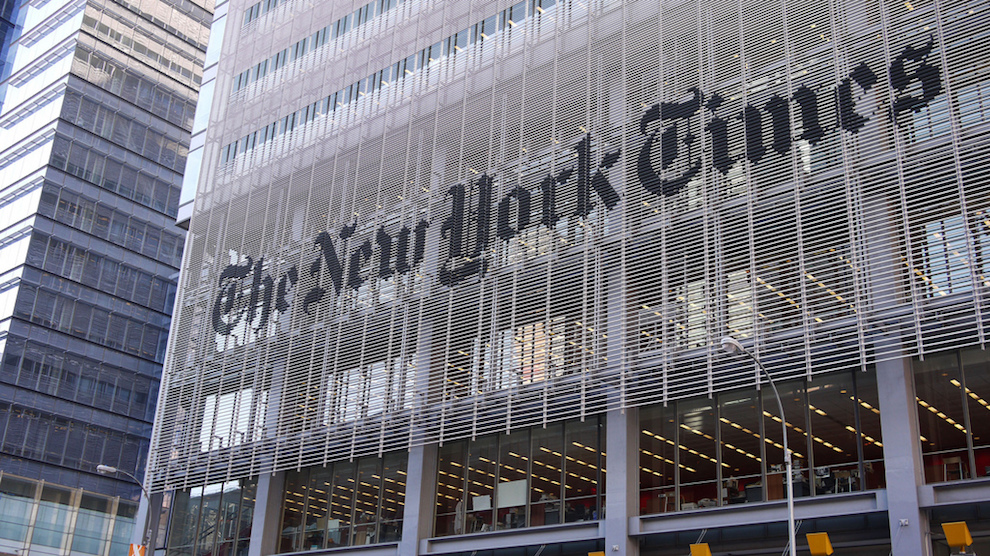
This isn’t actually a totally new idea for the Times; back in 2006, during the first podcast boom, the paper launched a daily podcast called “Front Page” that consisted of reporter James Barron summarizing the day’s front-page stories, in episodes that lasted roughly five minutes. That product, with its “routine inclusion of classical music stories,” was canceled in 2012, and the apparent differences between it and The Daily reflect how much the Times’ notion of what a podcast should be have changed. (For a good compare/contrast, listen to the last episode of the Front Page podcast here.)
The Daily, part of a broader Times podcast push that began last year with the creation of a new podcast team, contains a sense of urgency rather than a public radio–like calm and, of course, isn’t explicitly tied to a print product. Just as the Times’ daily meeting schedule has shifted from print-centric to something more digital, its audio strategy has shifted from literally echoing newsprint decisions to something more native to the medium.
“It isn’t quite a podcast — although you can listen wherever you listen to podcasts. It isn’t quite the radio — although the mechanics are largely the same. It isn’t quite the newspaper — although we’ll be drawing heavily on the journalism that powers The New York Times,” Barbaro wrote in an introductory post. (Spoiler alert: It…is a podcast!) “We’re in the middle of something big and complicated and my colleagues and I aren’t just telling the story, we’re living it,” Barbaro says in a three-minute trailer that includes clips of Donald Trump speaking on his refugee ban and of protestors chanting “Let them in.” “These times require something different from the Times.”I'm old enough to remember the last time a big newspaper-focused media company launched a product called The Daily https://t.co/RCp6zSnVPq
— David A. Graham (@GrahamDavidA) January 30, 2017
The 15-minute show will run Monday to Fridays, and will be released around 6 a.m. ET. There will also be a text-messaging component: “Michael will share context, analysis and thoughts on some of the day’s pivotal moments with Times readers via SMS,” according to the release. You can sign up for that here. Users of Amazon’s Alexa-enabled devices can subscribe to The Daily as a Flash Briefing, and it will also be available on Google Home.
This is going to be one of those things where as soon as you hear it you’ll realize you’ve been waiting for it forever https://t.co/Pux9YOAnd5
— max linsky (@maxlinsky) January 30, 2017
The podcast could build on the success of the Times’ daily briefing emails, which were called out in the publication’s recent 2020 report as “among the most successful products” the Times has launched, the report’s authors wrote:
The briefings are in many ways a digital manifestation of a daily newspaper: They take advantage of the available technology and our curatorial judgment to explain the world to readers on a frequent, predictable rhythm that matches the patterns of readers’ lives. We need more innovations like the briefings. We have dozens of regularly appearing features built for the print edition but not enough for a digital ecosystem. We need more journalistic forms that make The Times a habit by frequently enlightening readers on major running stories, through email newsletters, alerts, FAQs, scoreboards, audio, video and forms yet to be invented.
The existing world of daily news podcasts — especially ones created as podcasts rather than as radio shows — is relatively thin. The major radio operations release brief top-of-the-hour news summaries as podcasts, but NPR doesn’t release its flagship Morning Edition and All Things Considered in that format. Slate’s The Gist is daily but typically combines a Mike Pesca editorial and an interview rather than aspiring to cover the day’s news in depth. Monocle’s daily podcasts are rather Monocle-y. Especially as audio delivery evolves — away from terrestrial radio in the car and towards podcasts on smartphones, Internet-enabled auto systems, and home-based devices like the Echo — there’s room for an established news brand like the Times to move in on what has traditionally been public radio’s turf.
As Andrea Silenzi, host of the podcast Why Oh Why, wrote in a different Nieman Lab prediction for 2017 last month:As our audiences continue to grow, many new listeners will arrive seeking refuge from Facebook’s fake news buffet and Twitter’s ideologue clutter, while expecting the speed of news they’ve become accustomed to from over-the-air radio and television. With more production staff, original programming, and audience demand, in 2017 we’ll see the rise of more news shows than ever, all experimenting with how quickly they can respond to breaking news. Let the race begin.